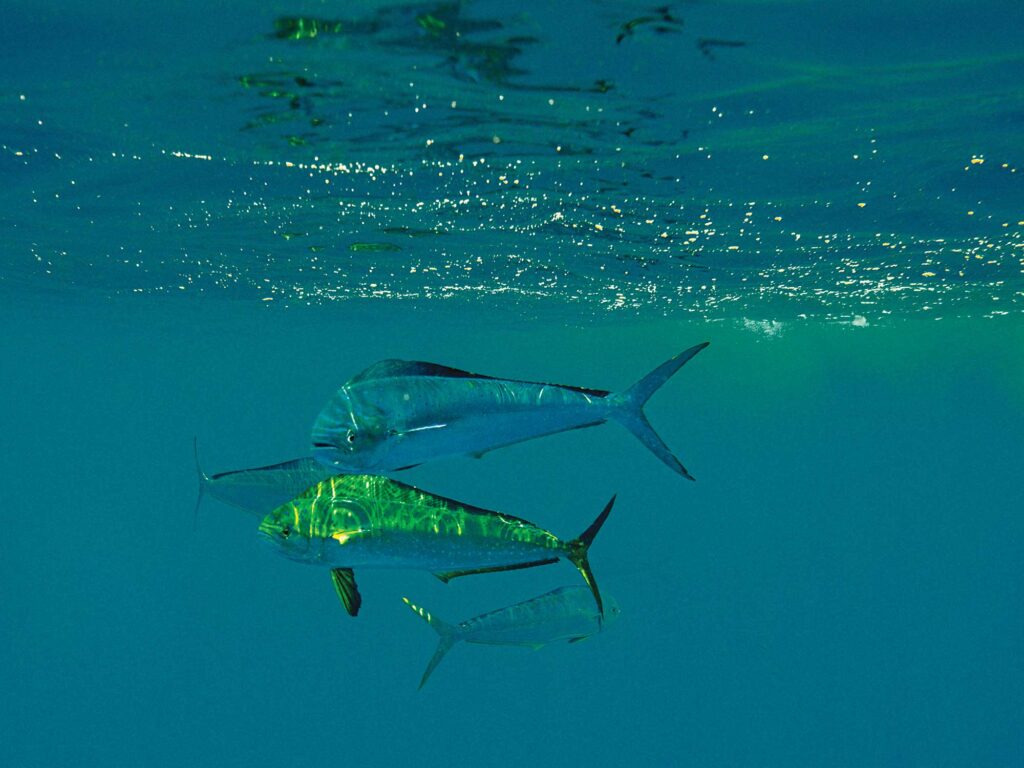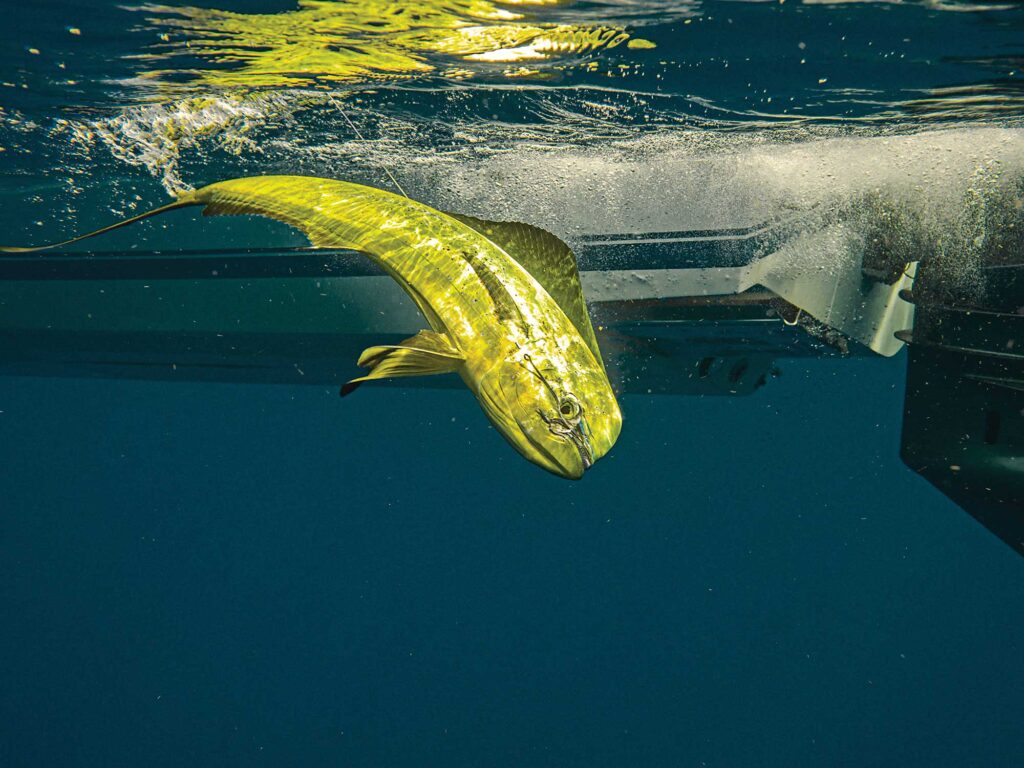Timing the SoCal Mahi Migration
 The annual migration brings big schools of mahi right into the backyard of SoCal.
Kevin Dodge
The annual migration brings big schools of mahi right into the backyard of SoCal.
Kevin Dodge
Autumn in Southern California marks a magical season for offshore anglers. Calm winds prevail, yet the warmth of summer still lingers amid the rich, blue Pacific waters, inviting a literal invasion of mahi from the south.
This is what many SoCal anglers live for—a once-a-year chance to target a species that otherwise inhabits subtropical waters well below the border and out of range for most private boats. The annual migration brings big schools of mahi from Mexico’s Baja California Sur, where this species is more commonly called dorado, right into the backyard of SoCal.
The opportunity to target SoCal mahi may last only a few weeks or sometimes more than a month in late summer and fall. When mahi show, timing is everything. Given this species’ propensity to roam far and wide, any procrastination may well result in opportunity lost. Here’s what to expect and how to prepare for your SoCal mahi mission.
 Mahi fishing amid the offshore waters of Southern California focuses on floating clumps of dislodged kelp that attract bait and gamefish.
Jim Hendricks
Hope Floats
Mahi fishing amid the offshore waters of Southern California focuses on floating clumps of dislodged kelp that attract bait and gamefish.
Jim Hendricks
Hope Floats
As in many other ocean waters, mahi in SoCal waters gravitate to floating objects. While this might be a wooden pallet, a large timber or even a dead whale, the objects most commonly targeted are clumps of kelp that break free from kelp beds and drift offshore.
These so-called kelp paddies develop into marine ecosystems, attracting and harboring a wide range of ocean life. The forage living in the shadows of kelp paddies in turn attracts schools of mahi, which might be viewed more as frequent visitors than residents of kelp paddies.
In fact, schools of mahi are often found roaming hundreds of feet away from a kelp paddy, and are rarely found hanging directly under the amber-colored weeds. Sometimes, SoCal mahi may lurk as much as 100 feet below the surface. The point is, there is no need to fish right on top of a kelp paddy, but rather in the general vicinity to try to intercept a roaming school.
Search TacticsBefore you can fish a kelp paddy, you have to find one. That’s not always a given, particularly in the early morning hours when skies are shrouded in heavy overcast, which is typical in SoCal. Cloud cover lends the ocean surface a monochrome glaze. So, it’s important to have all crewmembers scanning for the subtle signs of a kelp paddy while the boat cruises or trolls offshore.
It takes some experience to recognize a paddy at a distance under these conditions, but it’s often a slightly darker patch in an otherwise gray seascape. Using 7×50 marine binoculars or stabilized binoculars such as the Fujinon Techno Stabi 14×40 can help you locate paddies more easily.
Birds such as least terns (common seabirds off SoCal) can also help you locate paddies. Their white feathers stand out sharply against the morning gray, and flocks of terns often gather to rest atop the kelp. However, you might also spot them flittering close to the water’s surface around the paddy, a sign of feeding mahi.
 Anglers should fish in the general vicinity of a kelp paddy to try to intercept a roaming school.
Kevin Dodge
Where to Hunt
Anglers should fish in the general vicinity of a kelp paddy to try to intercept a roaming school.
Kevin Dodge
Where to Hunt
In forming your mahi game plan, remember that offshore ocean currents can concentrate paddies along certain corridors. For example, currents often stream strongly in the 25-mile-wide channel between the Santa Catalina and San Clemente islands, carrying clumps of dislodged kelp from their shores. The biggest concentrations of paddies tend to occur on the edges of the currents, where water slows down.
At the same time, a number of ridges and seamounts generate upwellings, eddies and rips amid the currents that can further concentrate kelp paddies. Keep this in mind as you plan where to hunt for paddies.
Size Doesn’t MatterKelp paddies vary in surface area, from the size of a garage door to as small as a doormat. While bigger paddies are easier to spot from a distance and are more enticing, the smaller ones can be just as attractive to mahi.
One element that attracts more bait and, hence, mahi and other gamefish are kelp “stringers” that dangle well below the paddy—as far as 50 feet or more into the depths. These can be more important than surface area.
Ultimately, any kelp paddy can attract schools of mahi, so it pays to fish each and every one you find. Also, just because a paddy did not produce at one particular time of day does not mean it won’t have fish around it at another time. So, note the location on your chart plotter with the idea of possibly trying to find and fish it again later in the day.
 A circle hook lodged in the corner of a mahi’s mouth helps keep the leader away from the teeth.
Kevin Dodge
Approach Strategy
A circle hook lodged in the corner of a mahi’s mouth helps keep the leader away from the teeth.
Kevin Dodge
Approach Strategy
Once you find a paddy, it can pay to approach in a methodical manner; many times, mahi will bite before you even get close to kelp. Rather than rush straight to the paddy, I like to slow-troll live sardines or mackerel starting at a distance of about 200 feet from the spot.
A trolling pattern that spirals inward lets you cover the full perimeter of the mahi strike zone. At the same time, toss out a few live sardines to bring fish toward the boat. It is not unusual to see free-jumping mahi in the waters around the paddy, and this helps show the location of the school at any given time.
It also isn’t unusual for the school to rush the boat as you’re slow-trolling. Seeing a big school of mahi with their royal blue pectoral fins gliding under the boat pumps up the adrenaline level. But fish swimming farther from the boat bite more readily than those that are closer. So, a long cast tends to draw a strike more quickly than a short one.
Hesitant BitersAn odd and sometimes frustrating phenomenon occurs once mahi migrate north to SoCal waters: They stop biting, or at least don’t feed as aggressively as they do in the waters off Mexico’s southern Baja California.
Some theorize that SoCal’s comparatively cooler ocean waters curb their appetites. Others point out that mahi grow accustomed to smaller forage fish such as tiny anchovies an inch or two in length in northerly waters, and so tend to ignore larger live baits such as sardines or mackerel.
A great example of this occurred in the 2022 season when schools of mahi stretching across acres of ocean moved into SoCal waters. Anglers did not need a kelp paddy to find them, as the massive schools swimming just under the surface became clearly visible. But few of these thousands of mahi would bite.
Some anglers found a way, including fast-trolling daisy chains of small hoochie squids along the edges of the schools. They picked off a few, but the real action did not occur until SoCal felt the remnants of Pacific Hurricane Kay. As the ocean waters settled in the aftermath of Kay, the massive mahi schools went on a feeding spree. Many believe the warmer water pushed northward by the storm swell made all the difference, lending credence to the theory that cooler water curbs the appetite among mahi.
Read Next: Mahi Mystery
 Late summer and early autumn bring warm ocean waters and glassy seas to Southern California, prime conditions for mahi fishing.
Jim Hendricks
Scaling Down
Late summer and early autumn bring warm ocean waters and glassy seas to Southern California, prime conditions for mahi fishing.
Jim Hendricks
Scaling Down
Anglers can’t count on a storm surge to save the day, so many find themselves scaling back to catch SoCal mahi. In recent years, for example, anglers have turned to 15- to 20-pound fluorocarbon leaders with smaller circle hooks such as a size 1 Gamakatsu Nautilus or Owner Mutu Hybrid. A circle hook lodged in the corner of a mahi’s mouth helps keep the leader away from the teeth and prevents saw-offs, but you still have to take it easy on a hooked fish to minimize break-offs.
I also like to use spinning tackle to toss live bait as far as possible from the boat, and if I see a school cruising by, I aim to place the live bait about 10 to 20 feet ahead of the pack. This seems to draw strikes more consistently than putting a live bait in the middle of the school.
Once I am hooked up to mahi, I grow ecstatic. These acrobatic fish are among my favorites to catch, eat or just see swimming in the ocean waters of Southern California. I can’t wait for this season’s mahi invasion.
Troll or RunThere are two basic modes of operation among private boaters when hunting for kelp paddies. One is to put out a lure spread and troll at about 7 to 8 knots while searching for paddies. The other method is to cruise at speed to cover water more quickly while on the hunt for kelp. There are merits to both. If you troll, you might actually hook into a free-swimming mahi, which could possibly bring a school to the boat as the pack follows the hooked fish. Live-chumming can also help keep the school around the boat. On the other hand, a boat on the run might find fish-holding paddies faster than a boat that’s trolling. However, a boat cruising at speed is also more likely to miss a distant paddy, especially amid the cloud-covered skies of SoCal’s morning hours.
It is really the captain’s choice, but to my way of thinking, trolling is the best option in the morning, as it gives you a better look across the offshore waters. However, once the sun is up, the amber paddies contrast sharply against the azure waters, and so that’s when I reel in the lures and start searching at a greater speed, around 18 to 20 knots.
Don’t Poach a PaddyUnfortunately, some private-boat anglers in Southern California rely on the unscrupulous practice of looking for stopped boats rather than looking for paddies while mahi fishing. What I mean is they wait for another boat to find a paddy, then zoom in to take advantage of all the hard work and time another crew has invested. We call it poaching a paddy, and it often leads to heated confrontations between boats.
This has happened to me too many times, so you will forgive me if I’m a bit salty on the topic. Good anglers find paddies of their own, while rookies fish for boats. Please don’t fish for boats. Exercise self-respect and pride in your abilities to locate fish. Find your own paddies.
The post Timing the SoCal Mahi Migration appeared first on Salt Water Sportsman.
- Home
- About Us
- Write For Us / Submit Content
- Advertising And Affiliates
- Feeds And Syndication
- Contact Us
- Login
- Privacy
All Rights Reserved. Copyright , Central Coast Communications, Inc.